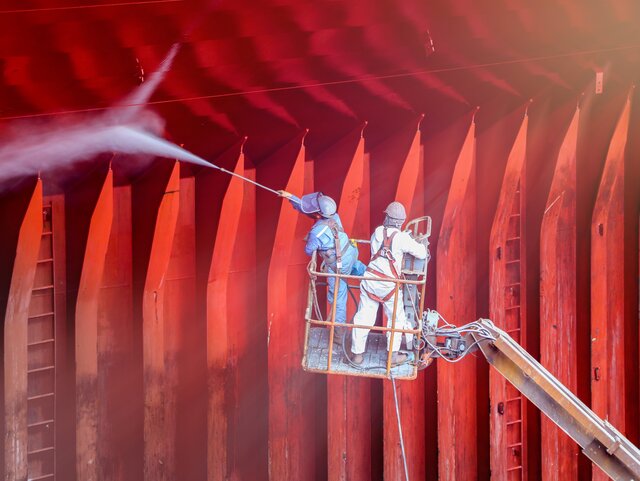Are your bulk carrier operations undertaking hold cleaning and preparation properly?
If they’re not, you could fail hold inspections and quickly find yourself facing substantial cargo claims, delays, additional cleaning requirements, survey costs and expensive off-hire disputes.
But you can avoid these issues by tapping into Brookes Bell’s bulk carrier expertise.
Hold cleanliness consultancy
There are many reasons why a vessel may fail a hold cleanliness inspection.
These can include factors such as excessive rust and paint flaking, previous cargo residues, odours and/or taint from paint or chemicals, infestations or wetness.
To ensure your vessels do not fail hold cleanliness inspections, you should make use of Brookes Bell’s hold cleanliness consultancy service.
Our Master Mariners will work with you, harnessing their experience and expertise, to ensure your vessels’ holds are sufficiently prepared for a hold cleanliness inspection, by:
- Conducting a careful review of the voyage instructions and charterparty in association with the vessel’s managers/charterers. The Master Mariner will clarify if there are any discrepancies in the cleanliness requirements between the charterparty and voyage instructions
- Checking that there is sufficient hold cleaning equipment on board. This will include a review of the necessary:
- Chemicals and applicators (which may be required for the removal of previous cargo residues)
- Hoses, brooms, extendable poles and scrapers
- Mucking winches and waste drums
- A review of the vessel’s combi/tobey gun, which should be capable of reaching the upper parts of the cargo compartments with sufficient pressure to remove residues and any loose rust/paint
- An analysis of the time required between ports for hold cleaning - factoring in considerations such as the weather on voyage and crew hours of rest regulations
- Considering MARPOL regulations with regards to the safe disposal of wash water and cargo residues
- Putting in place processes (if not already in place), for the collection and maintenance of good records and photographic reports on all hold cleaning/maintenance operations. In the event of a claim, these records will assist you in showing due diligence was undertaken
Cargo cleanliness experience
Different types of cargo require different types of hold preparation. At Brookes Bell, our Master Mariners have experience dealing with the three main types of cargo (which are categorised according to their cleanliness requirements).
Clean cargoes
Clean cargoes such as soda ash or mineral sands can potentially be damaged by any form of contamination.
Our Master Mariners understand that these clean cargoes require the hold to be ‘hospital clean’ before loading.
Moderately clean to moderately dirty cargoes
Cargoes such as grains, fertilisers and cement are normally deemed as moderately clean to moderately dirty cargoes and usually require the hold to be at a ‘grain clean’ standard of cleanliness before loading.
Dirty cargoes
Bauxite and some types of coal are considered to be dirty cargoes. As these types of cargoes are unlikely to be contaminated by any small amounts of rust or paint from the steel structures within holds, hold cleaning is not as high a priority.
Nevertheless, our Master Mariners always check the exact cleanliness requirements for these types of cargoes.
Experience of hold cleanliness standards
It’s important that you not only understand how different cargoes are classified, but also the cleanliness standards which they require.
Brookes Bell’s Master Mariners have an acute understanding of these standards and can work with you to ensure you don’t fall foul of them.
How is the hospital clean standard defined?
For a hold to be classed as ‘hospital clean’ it must be free of rust, loose rust, loose paint flakes and be free of previous cargo residues.
Ideally, all steel surfaces and fixtures, including the tank top plating within the compartment, should have good, overall paint coating.
This strict cleanliness standard is usually only achieved by vessels that only trade clean cargoes.
How is the grain clean standard defined?
A grain clean standard of cleanliness is often defined in the charterparty or voyage instructions as ensuring that the hold is “free of salt, loose rust scale and previous cargo residues”.
However, the grain clean standard does vary from jurisdiction to jurisdiction. For example, The United States Department of Agriculture (USDA) provides the following definition for grain clean; “a stowage area must comply with the standards of fitness established herein to be considered clean; dry, free of infestation, rodents, toxic substances and foreign odour…”.
A real-world view of hold cleanliness
Whilst the cargo categorisations above are widely established, the reality is that some ports apply them more stringently than others.
Our Master Mariners have experience dealing with the different ways these standards are applied and can advise you accordingly.
For example, some ports/cargo exporters will allow some minor loose rust and/or paint at the low/middle end of the ‘grain clean’ band.
Conversely, some port and exporting authorities require a slightly higher standard of grain clean, with Australia considered to be one of the strictest with a ‘zero tolerance’ criteria.
As such, grain clean isn’t so much a specified standard, but rather a set of cleanliness tolerances which vary from place to place.
Brookes Bell’s Master Mariners can help you navigate these sometimes confusing hold cleanliness requirements.
To find out more about Brookes Bell’s hold cleanliness consultancy service, contact us today.

